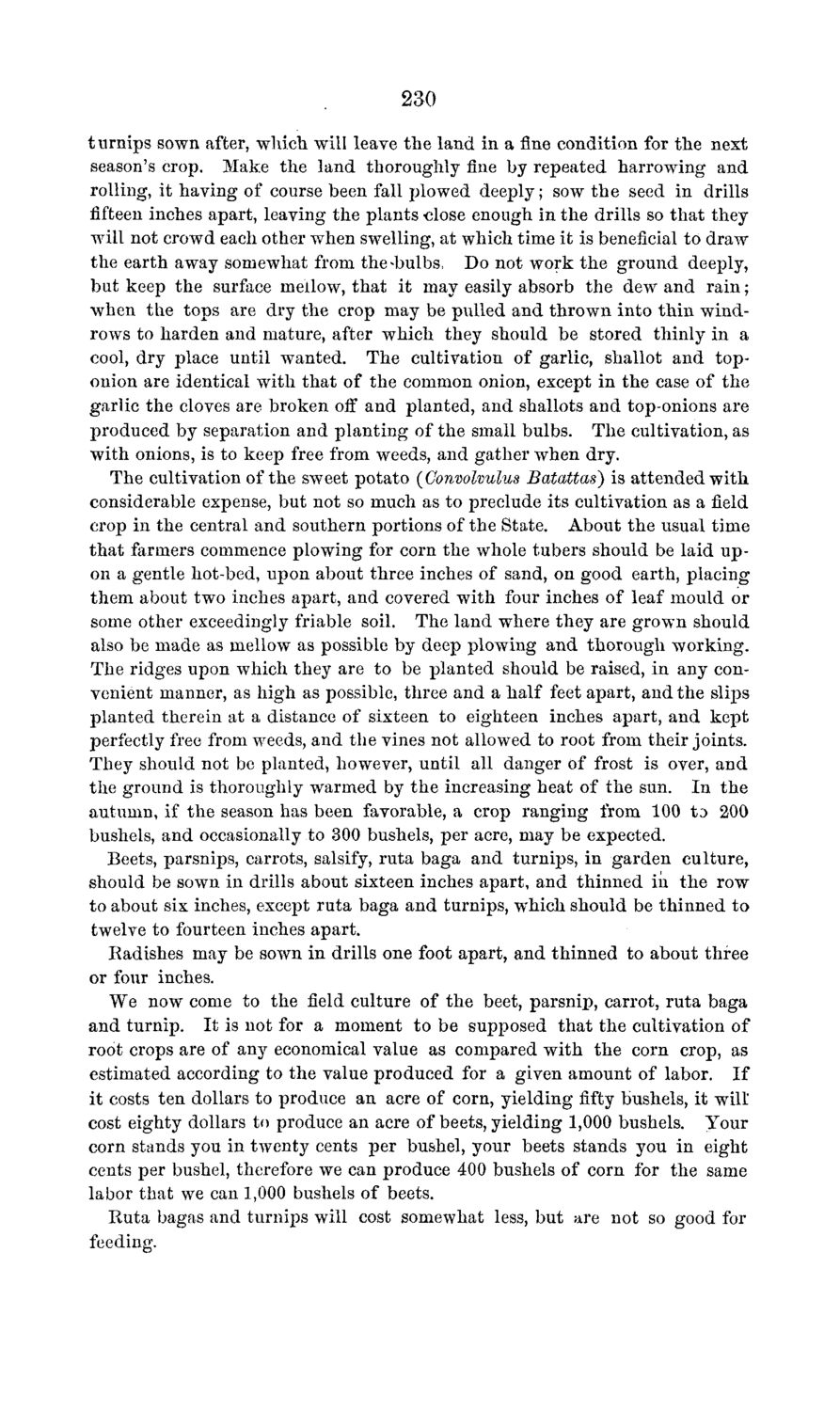| |
| |
Caption: Board of Trustees Minutes - 1869
This is a reduced-resolution page image for fast online browsing.

EXTRACTED TEXT FROM PAGE:
230 t u r n i p s sown after, which will leave t h e land in a fine condition for the next season's crop. Make the land thoroughly fine by repeated harrowing and rolling, it having of course been fall plowed deeply; sow t h e seed in drills fifteen inches apart, leaving the plants -close enough in the drills so that they will not crowd each other when swelling, at which time it is beneficial to draw the earth away somewhat from the-bulbs, Do not work the ground deeply, but keep the surface mellow, that it may easily absorb the dew and r a i n ; when the tops are dry the crop may be pulled and thrown into t h i n windrows to harden and mature, after which they should be stored thinly in a cool, dry place until wTanted. The cultivation of garlic, shallot and toponion are identical with that of the common onion, except in the case of the garlic the cloves are broken off and planted, and shallots and top-onions are produced by separation and p l a n t i n g of the small bulbs. The cultivation, as with onions, is to keep free from weeds, and gather when dry. The cultivation of the sweet potato (Convolvulus Batattas) is attended with considerable expense, but not so much as to preclude its cultivation as a field crop in the central and southern portions of the State. About t h e usual time that farmers commence plowing for corn the whole tubers should be laid upon a gentle hot-bed, upon about three inches of sand, on good earth, placing them about two inches apart, and covered with four inches of leaf mould or some other exceedingly friable soil. The land where they are grown should also be made as mellow as possible by deep plowing and thorough working. The ridges upon which they are to be planted should be raised, in any convenient manner, as high as possible, three and a half feet apart, and the slips planted therein at a distance of sixteen to eighteen inches apart, and k e p t perfectly free from weeds, and the vines not allowed to root from their joints. They should not be planted, however, until all danger of frost is over, a n d the ground is thoroughly warmed by t h e increasing heat of the sun. In t h e autumn, if the season has been favorable, a crop ranging from 100 to 200 bushels, and occasionally to 300 bushels, per acre, may be expected. Beets, parsnips, carrots, salsify, ruta baga and turnips, in garden culture, should be sown in drills about sixteen inches apart, and thinned in the row to about six inches, except ruta baga and turnips, wThich should be thinned to twelve to fourteen inches apart. Radishes may be sown in drills one foot apart, and thinned to about three or four inches. We now come to the field culture of the beet, parsnip, carrot, ruta baga and turnip. It is not for a moment to be supposed that the cultivation of root crops are of any economical value as compared with t h e corn crop, as estimated according to the value produced for a given amount of labor. If it costs ten dollars to produce an acre of corn, yielding fifty bushels, it will" cost eighty dollars to produce an acre of beets, yielding 1,000 bushels. Your corn stands you in twenty cents per bushel, your beets stands you in eight cents per bushel, therefore we can produce 400 bushels of corn for the same labor that we can 1,000 bushels of beets. Ruta bagas and turnips will cost somewhat less, but are not so good for feeding.
| |